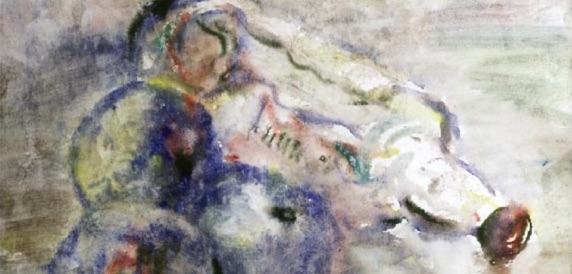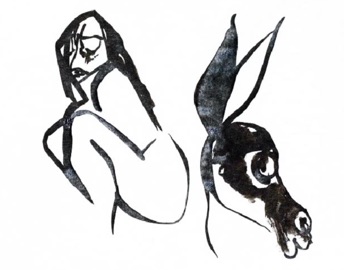Tuesday, Friday to Sunday 12:00 – 20:00
Wednesday to Thursday 12:00 – 21:00
Closed Mondays
Ticket office closes 30 minutes
before Museum closing time
Dear visitors! Note that the AZ Museum will be closed from April 1 due to the exposition change.



At the end of the 1950s in Russia, there appeared a new trend in art currently designated with different terms and concepts. Most often this art is called “non-official” or “non-conformist”, emphasizing its fundamental difference from the official social realism. Often, they talk about the “second Russian avant-garde” or the “soviet modernism”. The curator and the art director of the AZ Museum Polina Lobachevskaya suggested using a new, paradoxical term – Soviet Renaissance.
In the late 1950s in Russia, there appeared a number of artists who created some kind of the Renaissance of the fine arts, opening new forms, and, at the same time, the new horizons of spiritual culture of the second half of the XX century. It was encouraged with the "wind of change", which rushed into the life of a post-war generation: it revived the ideals of freedom, virtuosity and courageous search.
The AZ Museum's collection comprises the works of the main and the best representatives of the Soviet Renaissance. The true "Renaissance man" Anatoly Zverev, both for his contemporaries, and his descendants personified the concept of a free artist escaping all official frameworks. His friends and colleagues Dmitry Plavinsky, Vladimir Nemukhin, Lidiya Masterkova, Dmitry Krasnopevtsev, created original art universes, having etched their names in the history of global art. Intense search and profound enlightenment distinguish the works of the Lianozovskaya Group – Evgeny Krapivnitsky, Oscar Rabin, Nikolay Vechtomov, Lev Krapivnitsky. The works of Francisco Infante, Yulo Sooster, Oleg Tselkov differ in their philosophical strength. None of the listed artists and none of the other creators of the Renaissance have ever been accepted by the Soviet regime and given any state orders or privileges.
These artists quite often belonged to different trends and styles, but all of them were united with the idea of free future-oriented art. At their own time, they were in forced isolation from the global art stage. However, their innovative pathos and energy could not remain unnoticed. Works of practically all artists in the AZ Museum collection got into the most significant global collections in the middle of the XX century: from the MOMA in New York to the Centre Georges Pompidou in Paris. Today, there is an urgent need to reconsider these unique works once again, to evaluate their potential and relevance for future generations.
As it was mentioned before, a young art of the 1950s-1960s is quite often compared to the Russian avant-garde of the 1910s-1920s. One of the leading experts in this area Andrey Sarabyanov dwells upon the legitimacy of this idea: Russia is the country of contrasts. This feature predetermined the main characteristics of the art of the XX century, where the place "in the sun", i.e. next to the ruling authority, was taken either by the traditional academic art (in the broader sense – the realistic art), or the new art demolishing the traditions (but not denying the figurative).
Metamorphoses determined that time. A striking example is avant-garde. Before the revolution, it was a non-mainstream phenomenon unnoticed by the contemporaries. After the revolution, it immediately gained popularity with the Soviet regime. But as soon as the Soviet government got down to the culture, the situation changed dramatically – the avant-gardists were expelled from all offices and positions, and the Department of Fine Arts of the People's Commissariat of Education headed by Shterenberg was closed (1920). The alliance of avant-garde with authority lasted for less than three years. Then the avant-garde was forgotten, and it showed no presence in the art space.
Stalin died in 1953. The country buried its leader and cried. It buried not only the leader but the entire era. One man was gone, and the whole political system started to collapse. The new era took a slow start. The year 1956 and the XX Congress. The famous Khrushchev's speech of the cult of personality.
Society reacted instantly. This time was called the "thaw" for a reason. When the snow thawed in the spring and the nature awakened – then the sprouts of a new consciousness, new mindset came to life, new freedoms started to break through here and there. There was hope for the future, the opportunities earlier seeming impossible came out, the plans were made. New life was inspired into art.
The wind of change could not be stopped. Some whiffs penetrated even through the Iron Curtain and formed their air current. During the thaw, it already gained its strength and blew a stiff breeze.
This breeze gave birth to a new trend in art, which has not yet been adequately studied. Its representatives are called the non-conformists, the sixties, the second avant-garde, and the Soviet Renaissance. Each of these terms fairly reflects some aspect of the phenomenon in its way, but the exhaustive name has not been found yet. Maybe the term "Soviet Renaissance" in its paradoxicality expresses the essence of this phenomenon the best way.
But let's get away from the terminology. A comparison with the classical avant-garde gives some impressive results and shows a certain similarity. The avant-gardists were marginal at the early stages. The public attention did not extend beyond the mockery. To force people to speak about them, the avant-gardists resorted to some radical methods: scandalous exhibitions, public provocations with the engagement of the police, etc. The sixties employed almost the same set of means – home exhibitions, the participation of the police and other repressive authorities, destruction of works with the bulldozers.
Speaking of the stylistics, one should note that the sixties inherited their avant-garde traditions more from the European avant-garde than from the Russian one. When they started, the Russian avant-garde was still hidden in the depositories, and the western one was available in the books and albums brought from Europe. But when, finally, the Russian avant-garde came out, there was a stronger stylistic bond with it, than with the European one.
To understand the sixties, one should feel the novelty of their internal flame which glimmered to blaze into the new fire once again. Restrictions only fueled their inner fire. They thought themselves a generation capable of anything. They felt their inherent value.
Today, it's getting more and more evident, than the Russian art of the XX century was in the orbit of the European modernism. Eurocentrism – as an integral and inherent part of the Russian art – was either a stylistic dominant, or, on the contrary, provoked extreme antagonism, but was there all the time. No Iron Curtains or political opposition were able to change this orientation of Russian art.
To understand and study the items of art, it is essential to review their geographical concentration, either a museum or a private collection. Let us remind you of George Costakis – in many respects the discovery of the Russian avant-garde was his achievement, the first collector and the tireless promoter. But he failed to fulfil his dream of establishing the Museum of the Russian avant-garde; the conditions of that time prevented him from doing so.
Since that time, both the circumstances and the opportunities have changed. The Anatoly Zverev's Museum established in Moscow combines the Museum and the objective functions. It has a remarkable collection of the sixties, arranges the exhibitions on its basis, attracting people not only with a smart and refined selection of works but also with the unique design and application of the most recent audio and video technologies. Consistent and thoughtful cultural programs arranged by the AZ Museum make us hope that there comes a new era in the studies of the sixties' art.
By metro
We recommend travelling to Mayakovskaya metro station. The walk to the AZ Museum will take around five minutes. After leaving the station, turn first to the right into the alley, then moving forward, at the first intersection, turn left to 2nd Tverskaya-Yamskaya street. Walk a few meters. AZ Museum will be on your right.
By car
There are paid parking spaces on either side of 2nd Tverskaya-Yamskaya street or in the nearest alleys. Parking is limited, and on weekends and public holidays, the parking lots may be full.